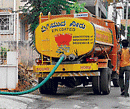
With indiscriminate sinking of borewells having depleted the underground water table in the City beyond distress levels, water wars seem waiting to implode like a dormant volcano in the years to come.
Sinking of borewells has become a necessary evil before construction begins at a site. However, this practice may see a quiet and much-desired burial, if powers that be do not take up efficient rejuvenation of ground water in an already parched City whose underground water table has depleted beyond distress levels.
Water wars seem to be imminent in the coming years if the civic fathers and planners do not address the alarming situation that is ballooning beyond control.
Indiscriminate sinking of borewells became commonplace in the wake of the once Garden City turning into Silicon Plateau, bringing in its wake a rash of IT parks as part of the much-touted development matrix, and with it self-contained gated condominiums and apartment complexes, adjacent to them, in the past 15 years.
While the ground water level in the core areas of the City has hit the bottom within three metres, in fringe areas, over-exploitation of ground water resources, by avaricious realtors, has seen the virtual disappearance of water underground.
As if the realtors’ wantonness to suck the water off the ground with impunity was not enough, one had Bruhat Bangalore Mahanagara Palike, too, joining the bandwagon, to make political capital of the situation, at a special council meeting two years ago, deciding, in their infinite wisdom, to tackle the City’s water crisis by sinking more borewells.
The result is not far to see. With heavy dependence on ground water, especially in seven CMCs and one TMC area (Yelahanka, Byatarayanapura, Dasarahalli, Bommannahalli, Mahadevapura, KR Puram, Rajarajeshwarinagar and Kengeri), as many as 973 borewells have gone dry. Of 1,375 borewells sunk by the Palike in the last two years, only 1,021 are functioning. The Palike even made attempts to dig wells, but only three of 120 have yielded some water.
Furthermore, with rapid urbanisation leading to an increased demand for water, especially in newly added BBMP areas, and residents spending huge amounts for potable and non-potable water, has seen water tanker business thrive on a large scale, with water being sold at exorbitant prices. With water seen as a lucrative form of making moolah, borewells have become the order of the day in order to specifically meet the needs and sell water to the parched areas.
With Department of Mines and Geology (DMG) estimating that over two lakh borewells have been sunk in City and number exponentially risen in recent past, it seemed it finally roused the State government, blissfully in slumber, to put in place the Karnataka Groundwater Authority in 2012.
With realisation dawning a little too late in the day, but nevetherless, to cap the exploitation of ground water and need for regulation, in 2011, Karnataka Groundwater (Regulation & Control of Development and Management) Act was passed and rules framed. A notification was issued making it compulsory to register all borewells, and compulsory permission before sinking any new borewell in notified areas by March 31, 2013. DMG has also identified 35 taluks in the State, which include Bangalore Urban district and BBMP areas which have been notified.
The drilling agencies will have to register with DMG. However, just over 200 agencies have registered. As regards individual borewells, only 150 households have registered. Both departments have done nothing to educate the masses about borewell regulation and the importance of conserving groundwater.
Incidentally, borewells were never the source of water in Bangalore City till the mid-80s when the first borewells were sunk using rotary drilling rigs which took months together until high-speed rigs, which took just around 2-3 days, were introduced. Although dug wells existed much before the advent of borewells, the City mainly depended on Tippagondanahalli (TG) reservoir and Hesarghatta reservoir for all its domestic needs.
With the commissioning of Caurvery water supply, borewells were almost unheard of till mid-90s. Although DMG was formed before Independence, it was in 1966 that for the first time Dr B P Radhakrishna, the then Director of Mines and Geology, initiated investigations for study of occurrence and availability of groundwater resources in the State. In 2009, DMG took up the study of ‘Groundwater Hydrology and Ground water quality in and around Bangalore City’ collecting over 3,000 samples over an area of 800 sq km.
The study said nearly 31 per cent of ground water samples collected was not fit for potable purposes. The study also said that overdraft of ground water in many areas had a steep decline in ground water level, which has resulted in drying up of unconfined aquifers and mining of ground water situation in many parts of the City.
With sinking of borewell up to 1,000 feet in many areas, it said the amount of TDS (total dissolved solids) and fluoride content in ground water had increased, meaning that the driller had reached to procure water from static resource after exhausting the dynamic resource from ground water.
Geologists say ground water dynamics is a very complex system and it is difficult to analyse the depletion levels of water table. However, if water is not procured even after going as deep as 1,000 ft, it is understood the aquifer has dried up. In such places, rainwater harvesting and ground water recharging methods are recommended to be adopted by residents to ensure water is put back into the ground to replenish it.